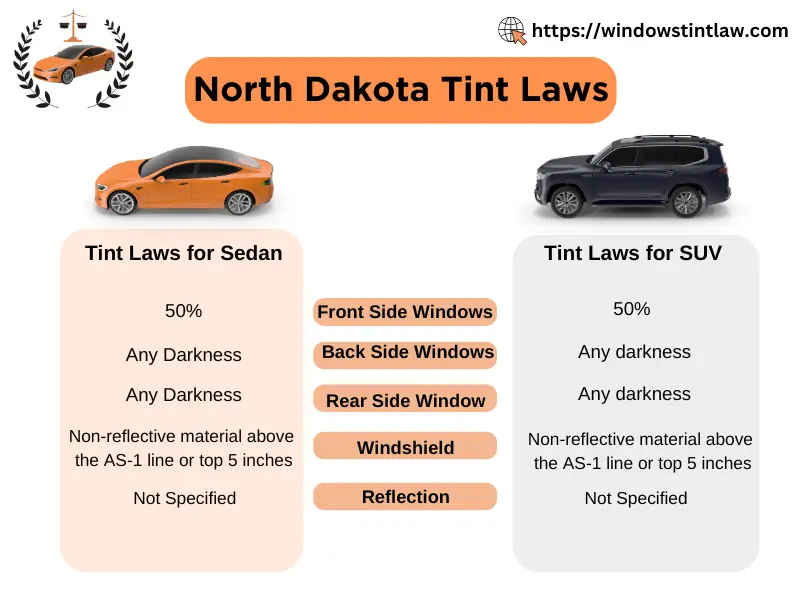North Dakota tint laws were legislated in 2003 which permits motor vehicle owners to tint their car and SUV windows within allowed limits.
Tinted windows have multiple benefits but obeying state tint laws is mandatory, to avoid tint tickets by law enforcement agencies. Actually tint laws mainly focus on Visible Light Transmission percentage which is also known as VLT. In simple words, VLT means the higher the Visible light transmission percentage lower will be the darkness of tinting material. The higher VLT percentage means more light can pass through windows and lighter will be tint shade.
Check out the below sections to understand North Dakota tint laws in terms of Tint Darkness, Tint reflection and other rules.
Overview of North Dakota Tint Laws
The below infographic shows the allowed limits for tint darkness and solar reflectance for all window types. Moreover, The windshield of any motor vehicle may not be shattered or in defective position so that it obstruct the driver’s vision.
Additionally, Every vehicle must be equipped with a mirror which can reflect to driver a view of highway for a distance of minimum 200 feet to the rear of such vehicle.

Darkest Legal Tint in North Dakota
According to North Dakota Tinting Laws, the following darkest legal tint percentages are allowed for Cars and SUVs. The below table shows the permissible limits for all window types.
| State | Front Side Windows | Back Side Windows | Rear Window | Windshield | Tint Reflection | Color Tints |
| North Dakota | 50% | Any darkness | Any darkness | Non-reflective tint above the AS-1 line or top 5 inches. | Not specified | No tint colors are restricted. |
Window Tint Reflection
Tint reflection limitations are not specified in the state laws. However, it is recommended to apply or affix the tinting materials with minimal solar reflectance. The covered or coated windows should not reflect more light than a standard vehicle window without any covering or coating material applied.
Hence, it is advised to install the right type of window tint which must not reflect light to large extent. As reflective tints produces glare which cause inconvenience for other drivers.
Other Rules and Regulations
Drivers are advised to follow some other rules which are listed below:
- Dual Side Mirrors: Dual side mirrors are mandatory if the side windows behind operator seat and rear windows are tinted.
- Tint Color Restrictions: No tint colors are restricted.
- Certificate: Window Film Manufacturers do not need to get certificate of tinting material they sell in North Dakota.
- Stickers: Sticker or Label to identify legal tinting is not required to display on vehicle windows.
Medical Exemptions
Currently Medical exemptions certificates or tint waivers are not issued to any individual due to his medical conditions. Previously North Dakota state laws issued window tint waiver for the persons with certain medical issues.
Hence, No body is allowed to install lower tint than the allowed limits, otherwise tint tickets shall be issued if caught with illegal tint.
Penalties for Violating Tint Laws
If any person caught with illegal tint, fine of amount $20 shall be issued and police office might ask you to remove illegal or unlawful tint from vehicle. However, if police caught someone with illegal tint applied to multiple windows the fine amount shall be increased. Normally, in most case cops usually give a single tint ticket. Police officers test the tint of windows by using an electronic Tint meter or window tint reader.
In Second and subsequent offences drivers may get higher fine amounts. But the window tint laws in North Dakota are not much strict as compared to other states.
